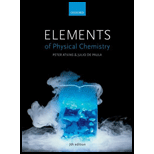
(a)
Interpretation:
How much
Concept introduction:
Half-life: The time taken for one-half of the nuclei in the sample to decay. The half-life of the sample is independent of the quantity of radioactive material and depends on the decay constant of the nuclide in the sample.
The decay constant (k) is independent of the quantity of radioactive material however depends only on the character of the nuclide. Various nuclides have various decay constants. The degree of radioactive decay depends on the decay constant and number of radioactive nuclei at specific time (
Half-life period:
Half-life is defined as the time taken for amount of the sample to reduce to half of its starting value. The symbol is
Half-life for a first order reaction is,
(b)
Interpretation:
How much
Concept introduction:
Half-life: The time taken for one-half of the nuclei in the sample to decay. The half-life of the sample is independent of the quantity of radioactive material and depends on the decay constant of the nuclide in the sample.
The decay constant (k) is independent of the quantity of radioactive material however depends only on the character of the nuclide. Various nuclides have various decay constants. The degree of radioactive decay depends on the decay constant and number of radioactive nuclei at specific time (
Half-life period:
Half-life is defined as the time taken for amount of the sample to reduce to half of its starting value. The symbol is
Half-life for a first order reaction is,
Want to see the full answer?
Check out a sample textbook solution
Chapter 6 Solutions
Elements Of Physical Chemistry
- Complete the two step reaction show the mechanism for all steps.arrow_forwardIdentify whether the carbocation or alkyl halide is methyl, primary, secondary, or tertiary.arrow_forwardDraw the products formed when the following alkene is treated with 03 followed by Zn, H₂O. Click the "draw structure" button to launch the drawing utility. draw structure ...arrow_forward
- Calculate the pH of 0.600 M solution of CH5N (Kb=4.37 x10-4) Hint: use assumption and check it!arrow_forwardDraw all stereoisomers formed when the following alkene is treated with mCPBA. Be sure to answer all parts. Part 1: How many stereoisomers of the product are possible? 1 Part 2 out of 2 Draw the product of the reaction, including stereochemistry. edit structure ...arrow_forwardA 3.30x10-2 M solution of monoprotic acid HA has a pH of 3.62. a) what is the percent ionization of this acid? b) what is the Ka of this acid?arrow_forward
- Identify as E1 or E2 and write the mechanism.arrow_forwardIdentify if their reaction is most likely SN1 or SN2 mechanism.arrow_forwardDraw the products formed when the following alkene is treated with 03 followed by Zn, H₂O. Be sure to answer all parts. draw structure ... smaller molar mass product draw structure ... larger molar mass productarrow_forward
 ChemistryChemistryISBN:9781305957404Author:Steven S. Zumdahl, Susan A. Zumdahl, Donald J. DeCostePublisher:Cengage Learning
ChemistryChemistryISBN:9781305957404Author:Steven S. Zumdahl, Susan A. Zumdahl, Donald J. DeCostePublisher:Cengage Learning ChemistryChemistryISBN:9781259911156Author:Raymond Chang Dr., Jason Overby ProfessorPublisher:McGraw-Hill Education
ChemistryChemistryISBN:9781259911156Author:Raymond Chang Dr., Jason Overby ProfessorPublisher:McGraw-Hill Education Principles of Instrumental AnalysisChemistryISBN:9781305577213Author:Douglas A. Skoog, F. James Holler, Stanley R. CrouchPublisher:Cengage Learning
Principles of Instrumental AnalysisChemistryISBN:9781305577213Author:Douglas A. Skoog, F. James Holler, Stanley R. CrouchPublisher:Cengage Learning Organic ChemistryChemistryISBN:9780078021558Author:Janice Gorzynski Smith Dr.Publisher:McGraw-Hill Education
Organic ChemistryChemistryISBN:9780078021558Author:Janice Gorzynski Smith Dr.Publisher:McGraw-Hill Education Chemistry: Principles and ReactionsChemistryISBN:9781305079373Author:William L. Masterton, Cecile N. HurleyPublisher:Cengage Learning
Chemistry: Principles and ReactionsChemistryISBN:9781305079373Author:William L. Masterton, Cecile N. HurleyPublisher:Cengage Learning Elementary Principles of Chemical Processes, Bind...ChemistryISBN:9781118431221Author:Richard M. Felder, Ronald W. Rousseau, Lisa G. BullardPublisher:WILEY
Elementary Principles of Chemical Processes, Bind...ChemistryISBN:9781118431221Author:Richard M. Felder, Ronald W. Rousseau, Lisa G. BullardPublisher:WILEY





